Being at the wheel of RML’s single P39 prototype, as it stalks the outside lane of Millbrook’s high-speed bowl, is like filling up at a deserted forecourt at 3am. Familiar but faintly unreal.
The major controls and ergonomics are as per the 992.1 Porsche 911 Turbo S donor, which RML would prefer arrived for the four-week, half-a-million-pound conversion process with fewer than 10,000 miles on the odo. As such, if you’re confident driving even a sweet little Carrera, getting about in the GT Hypercar (P39 is the codename) should be a doddle. Or so you’d think.
Underslung off the steering boss are four serious-looking rotary dials, some of which are angrily backlit in red. My view out of the rear window is also more compromised than that of any mad Lambo, mainly because there is no rear window, just a dark nook in which lurks a steel half-cage. And beginning just above my head is the five-foot-long intake tract for a 907bhp flat six. This ensures that bouts of heavy throttle sound like God whispering directly into your ear.
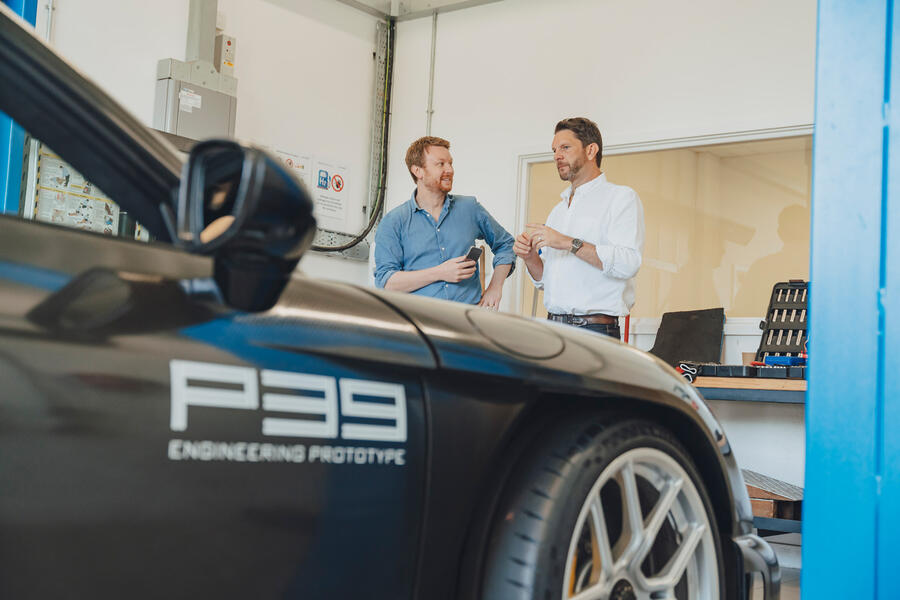
“Very much a beast with two faces” is how Michael Mallock (above, right) describes the car, which was revealed in full production form at this year’s Salon Privé. The GT Hypercar is the first ware from RML’s newly minted ‘Bespoke’ division. The department is overseen by Mallock and tasked with delivering rare-groove dream machines that delight clients and show major OEMs what the company can do, and do rapidly, by applying motorsport know-how to road car manufacture.
Though the ‘bespoke’ wrapper is new, the know-how certainly isn’t. P35 was the Ferrari 550 Maranello-based RML Short Wheelbase we drove in 2022, with its picture-perfect handling and stunning cabin atmosphere. P36 was a world-class Bizzarrini Strada revival. P37 was Lotus’s GT4 Emira. We can’t talk about P38 because it’s a secretive white-label project.

Paul Dickinson has also recently been brought in as group CEO, fresh from running Bentley’s Mulliner division, to make an operation with a distinct skunkworks flavour more corporate but “not too corporate”, a glint-eyed Mallock assures us at Millbrook.
We’ve joined RML for the day as the engineers fine-tune a machine that, somehow, was still only a top-down render being discreetly shown to would-be buyers at last year’s Pebble Beach. One face of this beast, as Mallock puts it, will be in its ability to lap the Nordschleife in less than 6min 45sec. That will make the GT Hypercar among the fastest road-legal track cars on the planet.
The other, more civilised face will be an ability to cover big mileages with ease. It’s why the suspension rates in the so est setting are a touch more languid than that on the donor car. Mallock is in a good place to judge his engineer’s efforts in this respect: subsumed within this naked-carbon prototype is his faithful old daily.

RML has previous when it comes to rapid ’Ring times, of course. It white-label-engineered the Nio EP9 that in 2017 took the record for the fastest EV lap with a sensational time of… 6min 45sec.
So P39 is an ambitious car, as chief engineer, ex-Lola man and endurance racing fanatic Adam Airey explains once we’re off the bowl and the car’s body has been carefully fed back into a garage that feels narrower than went we set out.
“The main driver to start with was the Nürburgring lap time using a 992-generation Turbo S platform and giving it our body,” he says matter-of-factly. “But then Michael said the car also had to drive like a Turbo S on the road.” It’s hard not to laugh when Airey explains that this was slightly problematic, given that by this stage his team had a full race car on their hands.

“So we’ve had to come up with a Jekyll and Hyde strategy on damping and springing,” he says. Forging a split personality involved working with R53 Suspension, these days a household name in our world thanks to its involvement with Gordon Murray’s new-wave supercars.
The approach is that the P39’s spring has a primary rate nearly identical to that of the regular Turbo S, but that under load comes into a stiffer rate before you get to race car-style wire-gauze bump stops. These are there to keep the floor off the ground in extremis, when the body is slammed to the deck in its lowest ride setting and close to a tonne of downforce is made at 180mph. It means RML’s car makes more downforce than even a 911 GT3 RS, although if kilos of aero adhesion are the new bragging rights in supercar circles, those owners can strike back by fitting the Manthey package, which just pips the P39.
However, hydraulically adjustable ride height is a feature no factory 911 can currently match. The system, which can drop the car 15mm in an instant, also runs the nose-lift and a full-blown DRS wing with brilliantly theatrical Le Mans-style lights in the endplates.
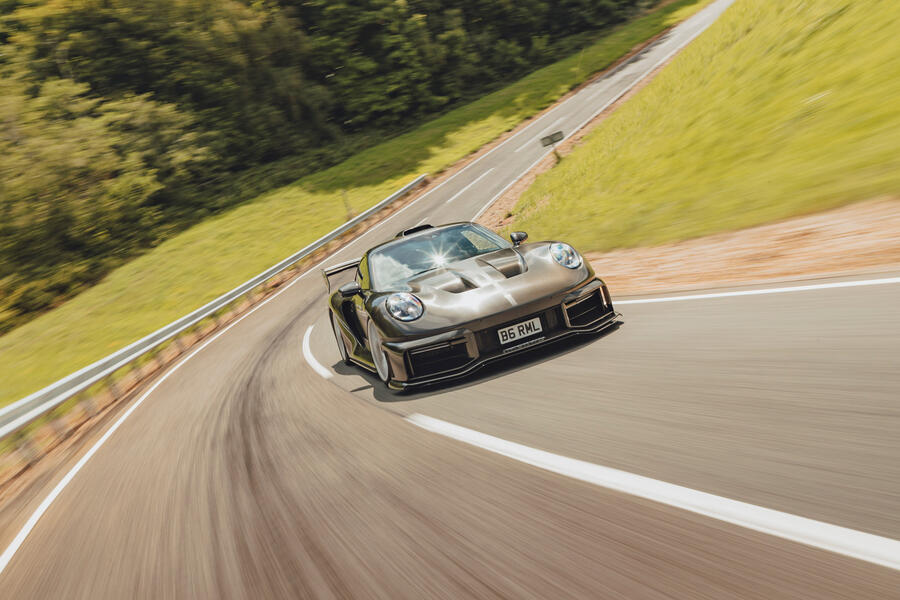
Opening the DRS flap increases your slipperiness by 23%, which is a similar effect to what you get on F1 cars. It slams shut if throttle application goes below 98%. Meanwhile, the dampers are manually adjustable but run in one of three electronically controlled presets that the driver selects via one of the four steering wheel rotaries.
Another of the three rotaries is for the aero setting: swivel to Track mode and a vast chin spoiler deploys from nowhere with a loud slap. Then you have the powertrain modes and, of course, ride height. The dials themselves appear lifted from the GT3 RS but are made by RML and feel OEM-grade.
At this point, I commit the sin of asking about the bodykit concocted by ex-McLaren designer Darryl Scriven, which evokes the fabulous 911 GT1 Strassenversion of 1997. Only 20 of these homologation specials were made, so RML’s GT Hypercar will be half as rare, with 40 planned.
It’s a slip of the tongue, because I well know the gold-tinged carbon-fibre that enshrouds the underlying 911 monocoque is no mere ‘kit’. Still, it earns me a rebuke from Mallock that’s justified when we visit RML’s production facility later that day. In one bay, an upturned carbon clam the size of a skip is waiting to be flipped over and bonded onto the car’s 911 core using only 4kg of adhesive.
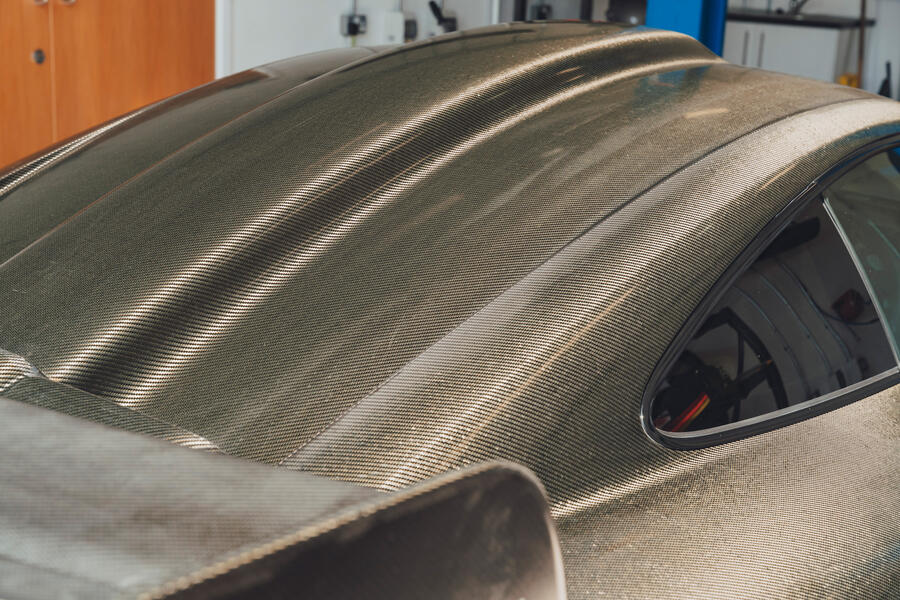
It’s an epic piece. Just 19kg but extending from A-pillars to rear bumper, encompassing the roof and the almighty scoop that rams air into the intake. The glue gives four technicians a 40-minute window to get the job done. It’s truly artisanal work, and along with another monumental front apron results in hardly any shutlines, for the full prototype racer aesthetic.
On the subject of the body, those intakes in the rear haunches? They’re no such thing. Unlike with the regular Turbo S, here their role is not split between feeding the engine and cooling the rear brakes. They do neither, being pure through-ducts that reduce drag by 3%. Find the right angle and you can peer right through them.
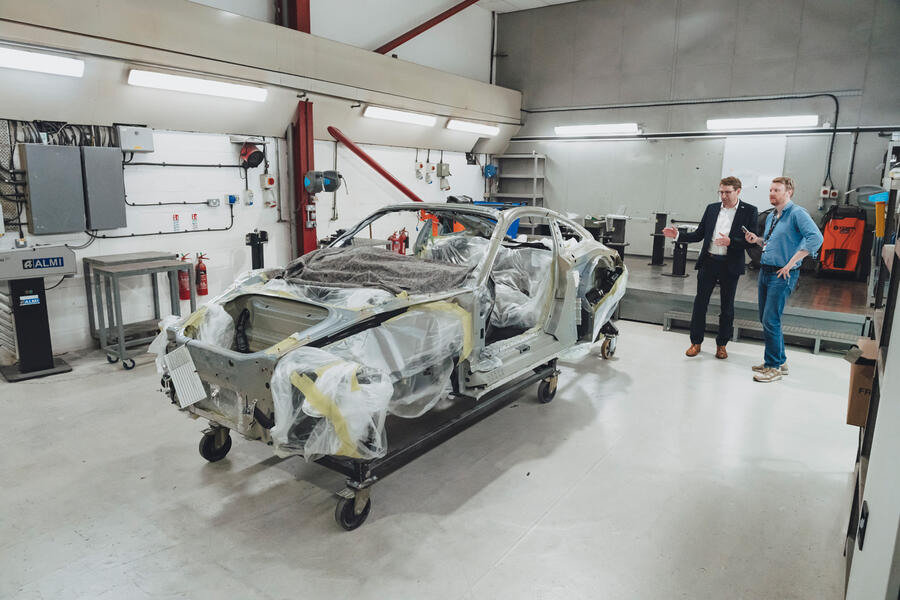
The GT Hypercar had to look totally spectacular, too. Obviously. Getting rear arches positioned just so relative to the long-tail body meant extending the underlying 992 wheelbase by 25mm via the suspension.
The tracks are also wider. Quite a lot wider, in fact – more than a wheel offset. It has necessitated new, elongated suspension links, which are beautifully machined, with geometry designed to retain the functionality of the Turbo S’s active anti-roll bars and rear-axle steering. Remapping these systems was not really an option, says Mallock.
To illustrate the complexity of modern cars, he tells me that when they swapped the seat from a 911 into a Taycan for materials testing, the radar and left window stopped working. As such, in its former life as a standard Turbo S, this prototype often carried dataloggers so RML could understand the detail of the sub-systems, and ensure the GT Hypercar suspension movements would be compatible.
While the fundamental kinematics of the donor car are thus largely unchanged, including the roll centres, the new lower wishbones do have camber shims for easy adjustment trackside.
Against all this, the small matter of 907bhp feels like a footnote. Hell of a footnote. Litchfield has done the work on Porsche’s 3.7-litre twinturbo motor, and after RML has stripped the donor car, the chassis heads west to Gloucestershire to have its heart put on anabolic steroids. The stock engine is robust enough that the internals need not be changed.
It’s more a question of “keeping the engine happy”, as Iain Litchfield puts it, with a surfeit of cooling, not least from uprated dual intercoolers. The uplift in power from the regular 641bhp of the Turbo S is also the result of a new electronic calibration and new turbochargers whose turbines are 6mm or so wider in diameter. This doesn’t punt up the turbo lag because it’s balanced out by the ram-air effect of the new intake and freer-flowing filters.
All this kit can be stuffed into the engine bay because RML’s long body takes the sting out of packaging constraints. The P39 has the largest catalytic converters on the market, as well as a full inconel exhaust smothered in F1-grade heat shielding. In RML’s workshops, the huge intake tracts – two polished carbonfibre anacondas curling down to each side of the intercoolers – are on full display.

Slide over the carbon sills, distended to align with the girth of the body, and how does it all feel? ‘It’ being twice the output of a BMW M2, suspension costing more than your average city car and a silhouette from La Sarthe ’97.
The engine’s malevolent burble and the eerie sense of being deep in the belly of something frighteningly potent put me in mind of the old Impreza, crossbred with an Aventador SVJ. At the same time, ride quality both taut and plush, along with this prototype’s hard-working vibe, is faintly McLaren 600LT gene-spliced with Caterham Seven Cup. All of which is to say finished RML GT Hypercars will feel unique.
In the default mode the engine is demure and puts out 740bhp or so. Ramp it up into Sport or Sport Plus and 589bhp per tonne is suddenly a reality, and is your cue to mentally buckle up. When the boost hits, acceleration is frantic – not landmine-intense but somewhere between bungee rebound and Josh Lewsey-style T-boning.
That said, even when 738lb ft wraps itself around the chassis at 4500rpm, with our Michelin Cup 2 tyres traction is just fine on this dry day, and Porsche's ceramic brakes feel supreme. It’s all manageable, in short. In the wet, without traction control? Different story, I imagine. Pure Group B.
On Millbrook’s hill route in its hunkered Track setting, the car’s stability is impressive. What the P39 longs for, though, is Pouhon or Stowe. Or Mutkurve. You sense its vast reserves of pace. Does it feel 6min-45sec-at-the-’Ring quick? Wouldn’t know; I've never been near that kind of madness. But the ceiling is clearly high – GT3 RS high, without the mechanical transparency.
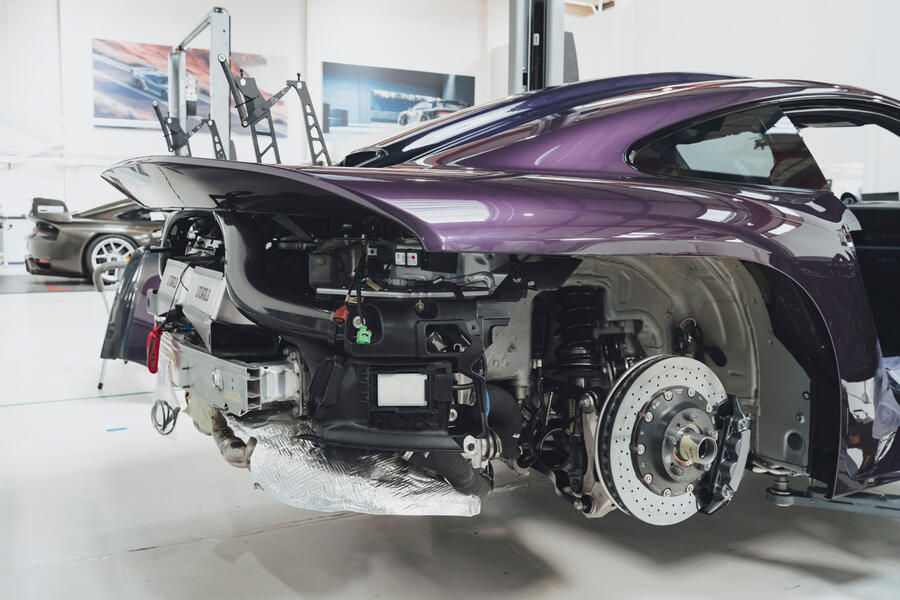
This isn’t to say the P39 isn’t fun. Through the medium-speed corners at Millbrook, taken in third gear, a neat rotational energy scythes through the heft of the steering. It’s trusty but not without delicacy. Note, though, that RML has not tinkered with Porsche’s ESP and traction control set-up. As a result, if you’re pushing on in the P39, the midway PSM Sport setting, overwhelmed and flustered, locks things down early. To get a real picture of the handling, it all needs turning off.
Despite its 30-page functional-safety booklet, the hydraulic system isn’t yet homologated, so there’s no DRS en route from Millbrook to RML’s base in Wellingborough. Mallock and I haul up into the car park 55 seconds later than intended.
Inside, I finally get to behold a finished article – the purple car ready for Salon Privé – and the quality of the fit and finish is undeniable. The scoops and gullies and the drama mirror the driving experience, channelling the excesses of the 1980s and 1990s but keeping things civil and conspicuously haute-automotive.
At £495,000 before tax and the optional Track Pack that brings the cage, the hydraulic ride height and the headline powertrain figures, it’s just as well.

I ask Dickinson if being a relative unknown next to giants such as Ferrari puts unbearable pressure on RML to deliver flawlessly first time.
“That’s how RML works with our motorsport roots,” he says. “You race on Sunday and the car has to be perfect. You don’t get a second chance.”
Indeed, the GT Hypercar is ready, in record time. The next task is to prove that wild ’Ring claim.
RML GT Hypercar specifications
Price £594,000 (plus donor car) Engine 6 cyls horizontally opposed, 3745cc, twin-turbocharged, petrol Power 907bhp at 7300rpm Torque 738lb ft at 4500rpm Gearbox 8-spd dual-clutch automatic, 4WD Kerb weight 1540kg 0-60mph 2.4sec Top speed 205mph Rivals Lamborghini Revuelto, Ferrari SF90, Porsche 911 GT2 RS








Join the debate
Add your comment
Too much power and, looks like it wearing a Max Power era bodykit. I wouldn't call it the ultimate 911.
The rear reminded me of the long tail 1977/78 Lemans cars.
I suppose if your affluent enough and fast cars are your thing, then this is a bargain relatively speaking.
It’s like achieving a personal best in geometry dash lite pure adrenaline!